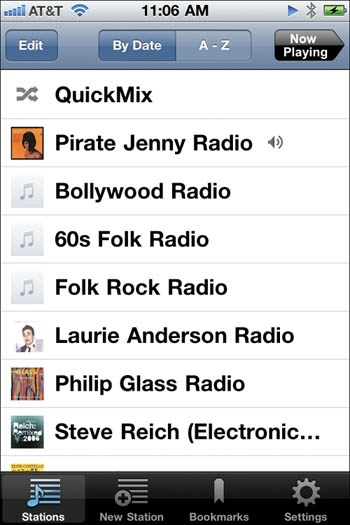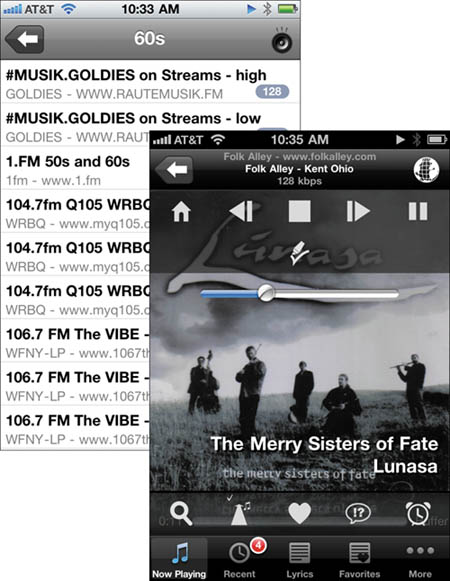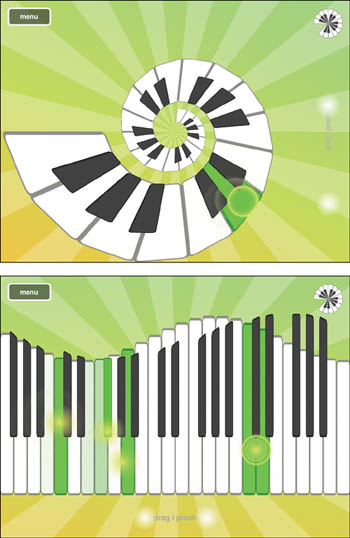3. Audio & Music
A mobile device can provide music on demand, whether it’s stored in memory or streaming over a Wi-Fi or cellular network. You can also make beautiful music of your own. The apps in this chapter stream, share, connect, and sing.

INTERNET RADIO / SONG QUEUES / STREAMING AUDIO / PLAYING / SINGING
Pandora

FREE • Pandora Media • http://5str.us/tno
Endless radio stations of your composition with optional ads
Open Pandora and you don’t release all the evils of the world—nor a little hope. (You don’t turn blue and tall, either.) Rather, you unchain an endless number of custom streaming radio stations that aim to match your likes.
You start by creating an account, which gives the firm some of your demographic information. Pandora is funded by advertising: you’re trading personal data for free music.
In the Pandora app, start creating custom stations. Tap the New Station icon at the bottom. In the Artist tab, enter a song title, artist name, or composer. The Genre tab lets you choose from several broad categories.

Pandora uses your selected song, artist, or composer as a jumping off point. For instance, I am a fan of the song “Die Seeräuber Jenny” (“Pirate Jenny”) from The Threepenny Opera. When I tap in that song title, Pandora offers me several different versions. I select Nina Simone’s, and the “Pirate Jenny Radio” station that I just crevated starts off by playing that artist singing a song from Porgy & Bess.

Tap the detail button while a song is playing (the bullet list icon in the upper right), and the Song tab exposes some of the logic that the Pandora system used in picking that particular number. Pandora uses a system called the Music Genome Project that attempts to match common elements across songs.
You can try to fine-tune Pandora’s results by tapping the thumbs up or thumbs down button. This works, but only to a certain extent. You can also skip a song, but not go back.
Because Pandora is a streaming service, you can run through cellular data if you listen to it constantly away from a Wi-Fi network. The app is designed to minimize 3G data use, and work at a higher quality over Wi-Fi networks. Pandora can play as a background app in iOS 4.
ooTunes Radio

$4.99 • OOgli • http://5str.us/bep
Every streaming station in the world and then some at your fingertips
ooTunes is a conduit to the vast number of streaming radio stations available worldwide. The app, which supports iOS 4 background audio, provides a number of discovery tools to browse and find stations that match your interest.
The list includes both broadcast radio stations that have streaming feeds and Internet-only radio stations. The bit rate is shown alongside stations; that’s the amount of data that’s sent, with a lower number working better over slower connections and consuming less bandwidth. Stations you like can be marked as favorites to find more easily the next time you launch the program.

The program also lets you plug in account information for the streaming Internet versions of Sirius Radio and XM Radio, and live365 VIP (an ad-free paid version of that service).
ooTunes has an alarm clock option to let you wake up to a station of your choosing. You can play Radio “RooLette” to have random songs plucked out and played for you.
AOL Radio

FREE • AOL • http://5str.us/jqr
Free access to CBS Radio’s broadcast and streaming stations
AOL Radio lets you tune in to CBS Radio stations. CBS Radio operates over 200 terrestrial broadcast stations around the United States, and also offers 25 streaming format stations. The app can use location to find those nearest you.

QUp

$0.99 • Dan Pourhadi • http://5str.us/vry
Manage an active list of music on the fly straight-through or shuffled
QUp is an app that, before you use it, you don’t know you need it. The program provides extremely fine and well-considered control over creating and managing a persistent playlist of music. It fills in missing pieces in the iPod app.

The software is like one super playlist. You select music to add from a music view that shows your whole audio library (podcasts excluded), listing Playlists, Albums, Artists, and Songs. The More view adds Compilations, Composers, and Genres.
From any display, you drill down to songs or albums, and can tap a + next to Add All Songs (including at the top level to add all your music) or tap a + next to any individual song.

Tap Done, and the list is ready to go. The play view shows album cover art (where available) filling the screen. If you tap that view, the bottom half previews the next track with an album cover, the song title, its album name, and the artist.
You can advance back and forth through upcoming songs and tap to jump to the track you’ve selected. And you can turn shuffle play on and off as well from this view.
Tap the list icon at upper right, and you can review and manipulate the songs you’ve chosen. Tap a song to move it to the top of the queue without interrupting music that’s playing. Tap the Shuffle button and you can resort the whole list and see the results.
The list view also lets you see a compendium of artists and albums, and search among the items in the playlist.
The software’s only substantial missing feature is the ability to save custom QUp playlists you can bring back to play again later.
Consideration
QUp can’t play music protected by DRM, which means any audio you purchased from the iTunes Store before Apple stopped selling protected albums and songs.
Airfoil Speakers Touch

FREE* • Rogue Amoeba Software • http://5str.us/2r7
Pass audio from computers running Airfoil to your iOS device
Think of Airfoil Speakers Touch as turning an iOS device into a portable speaker. The app works with Rogue Amoeba’s Airfoil commercial software for Mac OS X and Windows. Airfoil captures and redirects audio that’s playing on a computer to a variety of devices: other computers, AirPort Express, Apple TV, and mobile hardware running this iOS app.
For Airfoil Speakers Touch to work, your iOS device must be on the same Wi-Fi network as the computer from which you want to stream audio.
Setup is simple. Install Airfoil on a computer on the network, launch the Airfoil Speakers Touch app, and select the device as a destination from the computer software. Because the app supports background audio, it continues to play music even if you switch to another program. If you’re on a shared network, you can still stream without fear of others listening in—you may not want them to know that you’ve got Depeche Mode on infinite shuffle—by setting a password in Settings within the app.

Airfoil Speakers Touch works as a perfect complement to remote control apps. With Apple’s free Remote app (see p. 175), you can control iTunes on the same computer that’s streaming audio from Airfoil to your iOS device. You can also use the app to create remote headphones. While watching a video across the room shunt the audio to your iOS device and plug in earphones.

Requirement
*Paid desktop software must be installed on the same network. A demo version of the desktop software is available. It works for a short time for each session.
Ocarina

$0.99 • Smule • http://5str.us/5dm
Unearthly music by blowing on the microphone
One of the earliest iPhone apps to get attention after Apple opened up its operating system to outside developers was Ocarina from Ge Wang, a Stanford University professor. You blow into the microphone as if it were a wind instrument—the ancient ocarina, to be exact.
As you blow, you cover or uncover combinations of four virtual openings on the touch screen. Despite the simplicity of the instrument you can play complex songs. (It works better without a case, which can make it hard to handle the phone as an instrument.)
You can tune Ocarina via the app’s settings to other keys and to Greek modes like Ionian. (A little joke about the game The Legend of Zelda is thrown in with Zeldarian being one mode you can select.)
You can opt not to use a mic or headset by setting Touch Mode to On. This produces all tones at the same volume instead of responding to the amount of breath. (That’s the only choice for the iPod touch.)
All the software from Smule (or SonicMule) has a social component as well. In Ocarina’s case, you can tap a globe icon and hear people playing all over the world, some quite expertly. Tap the heart icon, and you’ve contributed toward a particular player moving into Top Melodies as well as adding them to your My Loved list.

You might wonder how you teach yourself to play songs on the Ocarina. The answer can be found on SonicMule’s Web site, where sheet music uniquely transcribed for Ocarina can be found. The form takes just a moment to learn.

Glee

$0.99 • Smule • http://5str.us/1ec
If you sing in the shower, you don’t have to love Glee to love this app
Conceive of the original Guitar Hero mashed up with karaoke, and you’ve figured out the Glee app from Smule. While you sing along with the instrumentals of songs culled from the show, starbursts explode as you sing. A visual display of the relative pitch of the note gives you feedback as you fix your pitch.
Miss the notes, and you can opt to have your singing auto-tuned electronically altered to fit the right note, no matter what you sing.

Rack up starbursts (which count as points) and compete on a daily basis with other Gleekers—fans of the show—worldwide. Or you can just sing for yourself.
Your performance can be recorded, and you can listen to yourself. And you can send a copy of the song to others via email or upload to Facebook, tweet it, or post it on MySpace.
The app includes a few songs at no cost, and you can buy additional tunes for 99¢ each. I recommend “Bohemian Rhapsody “and “Dream On.”
Your song can also be “broadcast,” or uploaded to a central Glee repository, which requires a free account.
Smule’s apps are all about sharing, and Glee is a worldwide phenomenon. Tap a Listen button on the home screen, and choose people performing with the app all over the world, join in on songs as another singer, and invite complete strangers (as well as friends) to be covocalists on a track.
The app brings all of the best aspects of karaoke singing (including showing you the lyrics) with tonal correction (and optional reverb). Even better: with the benefit of anonymity, sing out unselfconsciously. Go ahead: belt a tune! We won’t judge you.

Warning
Listening to yourself sing can be a humbling experience, but this app can teach you to sing better.
Magic Piano

$0.99 • Smule • http://5str.us/z7s
A piano without keys
Magic Piano is more of an approximation of the sense of a piano than a literal intrepretation. The app allows enjoyable exploration of notes and melodies, but I wouldn’t recommend you try to play a tune. (They all laughed when I sat down to play!)
The program features four keyboards, all of them a bit strange, but interesting. You tap the circular key icon at the upper right to cycle through them.
The keyboards are a spiral, a straight line (with undulations), a circle, and invisible. In each mode, you can tap multiple keys at the same time to produce chords. (An iPad can record up to about 10 separate finger taps at once, and Magic Piano works with that.)
The spiral and circle modes are just for playing around, while you can experiment with real music in the straight keyboard. With the circle or straight layout, pinch and expand to change the number of keys (and their width) shown on screen. Swipe left and right to move up and down the keyboard.

The menu offers other interesting options, like Songbook. The app downloads a score for a song you select from a modest list, like Pictures at an Exhibition. Notes start descending as spots of light from top to bottom. Tap the spot in the order of descent, and you’re playing the song.
When you play, your music is beamed out to the rest of the world (using a name you enter in Settings). You can listen in through the World option, or join in by tapping Duet. That mode matches you up with someone likewise seeking a partner. Your respective positions are shown on a globe while you play.

Note
The invisible keyboard option works just the same as the Songbook mode only without notes dripping down.
Soundrop

FREE • Develoe • http://5str.us/ju3
Magical musical effects by drawing lines that act as chords for bouncing balls
Fascinating patterns emerge from simple actions. That’s the key to understanding (and loving) minimalist music from artists like Steven Reich, and the key to falling in love with Soundrop.
Soundrop has no goal. Rather, a ball drops, and you draw lines. The lines are chords; the length affects the tone produced when the line is hit. Longer lines produce deeper notes.
The balls bounce off the lines with some semblance of physics (with very low gravity) to produce melodies controlled by changing the angle and length of lines. You can produce fast-moving cacophonies, or slow, ponderous dirges.
The free version lets you explore simple notes. An in-app upgrade adds four elements: multiple instruments, which you assign to different colors used to draw lines; physics modifiers to change gravity, friction, and bounciness; the ability to drop multiple balls at once; and the option to save a “game,” so you can restore your melody.

While Soundrop doesn’t have a goal and there is no scoring, you strive with the app to make interesting music instead of noise. Which may be the purpose of life itself.

